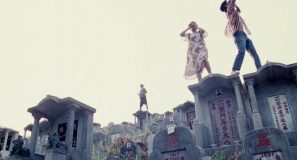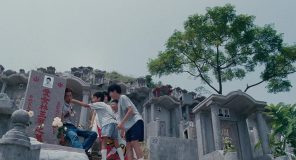MADE IN HONG KONG, DIR. FRUIT CHAN (1997)
Wo Hop Shek Cemetery, North District, Hong Kong
Made in Hong Kong, premiered in 1997, is an independent film written and directed by Fruit Chan. It narrates the story of a group of marginalized and disadvantaged young people in Hong Kong society — low-rent triad Autumn Moon, his retarded friend Sylvester, and his lover Ping, a patient with fatal kidney disease. Although they struggle to live, they are all driven to death in the end. With the film closely related to death, the Wo Hop Shek Cemetery1 is a critical setting that appears three times in the movie and where two major scenarios occur.

- Wo Hop Shek Cemetery. A picture from Google Map.
In my impression, a cemetery is a place that people seldom go to and gives me a solemn and heavy feeling. However, the director makes it an important setting and adds contrasting elements. Through characters’ actions and interaction, the Wo Hop Shek Cemetery becomes a meaningful space from an indifferent place for the main characters.
In the first scenario, the cemetery seems to be a paradise for Moon, Ping and Sylvester, where they jump, run, and shout breezily with the light soundtrack. The empty sky takes up a considerable part of the scene by high angle shot, adding atmosphere to the joy of freedom and release in contrast to the cramped and hypocritical city. Nevertheless, as the place closest to death, it also plays the role of an implication of their tragedy. The intertexture of grey background and delighted emotions forms a kind of decadent beauty, youthful while desperate.

Moon, Ping, and Sylvester stand on gravestones, shouting. A scene from Made in Hong Kong, 1997, directed by Fruit Chan.
In the second scenario where the story draws to the end, failed to find hope and the meaning of his existence, Moon finally shoots himself by Ping’s gravestone in the cemetery. His corpse is later discovered by a couple of playing kids with cheerful voices. This “mismatching” brings me a touch of cruelty instead. The cemetery is where the Moon, Ping, and Sylvester genuinely become friends and where the tragedy is born. Innocent children who don’t yet understand death are often seen as the new blood of society and a symbol of hope; however, they may grow up to be another “Moon,” “Ping,” and “Sylvester” in the current social situation.

Some kids find Moon by Ping’s gravestone, who has been dead. A scene from Made in Hong Kong, 1997, directed by Fruit Chan.
As the director Fruit Chan expressed in an interview, “the story of this protagonist, his struggle, his growing up, his lifestyle, was also very common for a lot of young people at the time.” 3 Moon’s story reflects the lifestyle of many young Hong Kong people in that period, and furthermore, it also reflects the plight of Hong Kong society in the pivotal year of 1997. The cemetery signifies the confusion and hopelessness about the future.
— Chen Yudan 3035844601
Notes:
1 Wo Hop Shek Public Cemetery, in Wo Hop Shek near Fanling in Hong Kong, is the largest public cemetery in Hong Kong.
2 “Wo Hop Shek Public Cemetery,” Google Map, March 20, 2022, https://www.google.com.hk/maps/place/和合石墳場/
3 “Interview: Fruit Chan, 20 Years on from Made in Hong Kong.” Interview by David Pountain, https://www.filmdoo.com/blog/2017/05/29/interview-fruit-chan-20-years-on-from-made-in-hong-kong/
You may utilize the concept of space/ place to discuss how film adds another layer of meaning to the Cemetery. I wonder if you have done any virtual field trip/ research on the place? As it seems that all the images you have selected are from the film. It is important to show how it appears in reality to highlight the contrast that is shown in the film. You have pointed to specific scenes to analyze the place, but it would be nice if you could pinpoint specific spots in the cemetery to illustrate how they were being ‘unusually’ used in the film for deeper analysis.